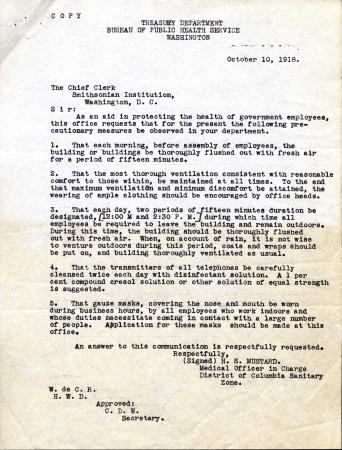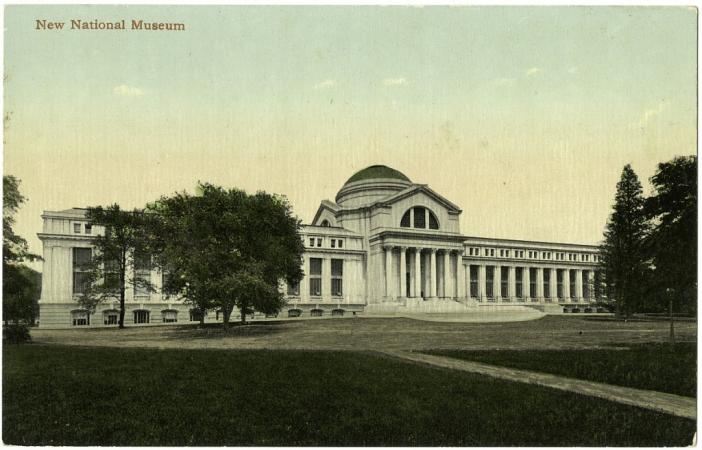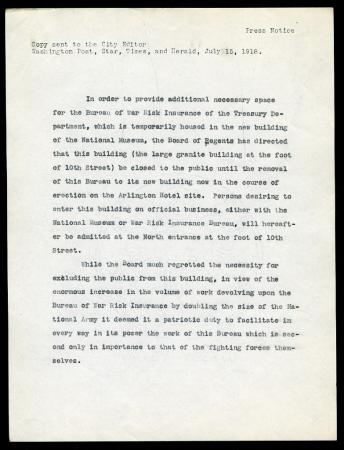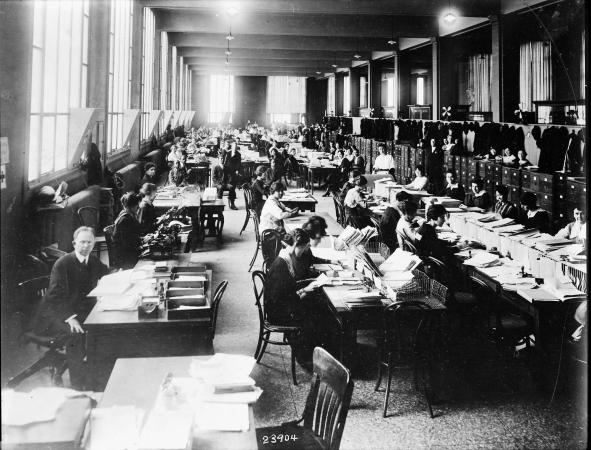Some years ago, as I was checking Natural History Building management records to answer a reference question, I came across a very strange memo. It was from an H.S. Mustard, Medical Officer in Charge with the District of Columbia Sanitary Zone in the Bureau of Public Health Service. Mustard ordered the Smithsonian to take various precautionary measures.
1. Before staff arrived, buildings were to be thoroughly ventilated.
2. Maximum ventilation must be maintained.
3. Twice per day, staff must go outdoors while the building was flushed with fresh air.
4. Telephone transmitters and other areas were to be disinfected.
5. Gauze masks, covering the nose and mouth, were to be worn by employees when indoors and near other people.

I was puzzled until I looked at the date, October 10, 1918, at the height of the 1918 influenza pandemic! First found in Europe, the U.S., and Asia in the spring of 1918, that pandemic infected over 500 million people worldwide and led to fifty million deaths. Around 675,000 Americans succumbed to the disease. This virus took its toll killing the very young, young adults, and the elderly. Additionally, this outbreak overlapped with major conflicts during World War I, so soldiers, packed together in barracks, easily spread the virus among themselves and to the next battle site. By October of that year, communities across the globe were devastated by the disease.

But during wartime, soldiers weren’t the only people who could not quarantine or practice what we now call social distancing. During the first pandemic outbreak, federal workers from the Bureau of War Risk Insurance joined Smithsonian employees in the overcrowded the United States National Museum, now known as the National Museum of Natural History.

The new museum opened in 1910 to great fanfare. Just seven years later, in October 1917, Smithsonian Secretary Charles D. Walcott agreed to temporarily close its spacious exhibit halls after the U.S. entered into World War I to house federal workers from the Bureau of War Risk Insurance. The newcomers quickly went from occupying 25,000 square feet to 138,600 square feet of the exhibit halls, which housed over 5,000 employees. As you can see in these photos, thousands of their clerks were packed into large open work spaces, just inches from their colleagues. One sneeze or cough could spread germs to numerous people working nearby. In an era before antibiotics, many patients died not just of the flu, but of related bacterial infections such as pneumonia.

The Smithsonian followed Mustard’s guidelines, sending home those who appeared to be sick, evacuating the building twice daily with no exceptions, cleaning door handles and water fountains, and ensuring people wore face masks. By late November 1918, the infection rate was subsiding and Mustard cancelled the order. But the following year, the influenza returned, continuing its deadly path and precautions were once again taken. The War Risk Insurance employees moved to a new facility in March of 1919 and, after refilling the now-empty halls with exhibits, the museum reopened on April 11, 1919.

We, like you, have many more questions about these events but the answers are buried in an archives that is closed during this current pandemic.
Related Resources
- 1918 Flu Pandemic, Centers for Disease Control and Prevention
- WWI: The Smithsonian on the Home Front, Smithsonian Institution Archives
- The Deadly Virus: the Influenza Pandemic of 1918, National Archives
- “The 1918 Flu, 100 years later,” by Jessica A. Belser and Terrence M. Tumpey, Science Magazine
Produced by the Smithsonian Institution Archives. For copyright questions, please see the Terms of Use.

Leave a Comment